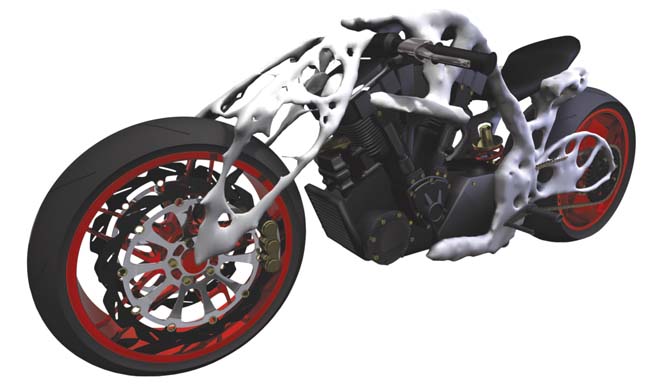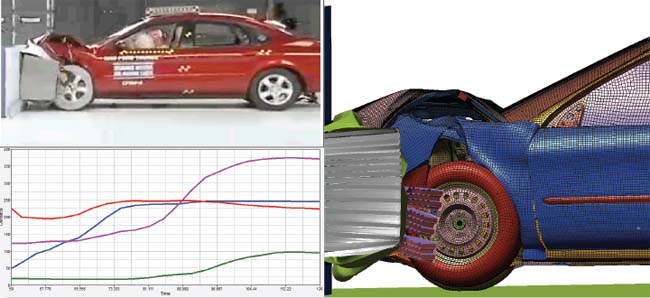Latest News
December 1, 2010
By James R. Scapa
Less than three decades ago, the ingenuity of engineers was the primary force for improving the quality and reliability of products. Engineers conducted a great deal of performance testing, but they were restricted by slow and deliberate manual processes. Testing done by hand was largely a matter of trial and error, with knowledge accumulated over periods of months and years. It entailed exhaustive prototype testing, and failure in the field often was an unavoidable step in the validation process.
 Today’s CAE software can be used to find the best design solution to meld creativity and product performance. |
And then computer-aided engineering (CAE) came along. The art of finite element analysis (FEA) has evolved into a dependable computer-simulation science, and its limitless impact can be seen across the creation of everything from automobiles and airplanes to cell phones and golf clubs. Simulation is now in the driver’s seat, pushing product development timelines, creating innovative concept designs, and improving product quality and reliability along the way.
A number of market factors helped push computer simulation to the forefront, including the increasing sophistication of consumers coupled with the emergence of the global online marketplace. The velocity of change in the market compelled reductions in both price and development time.
As engineers, we were able to respond effectively to those demands by leveraging simulation, and advancing the methods and application to improving design. We are seeing the convergence of four dynamics in the evolution of simulation: people, hardware, software and business models.
 Simulation and analysis data now flows more easily among departments, allowing decisions to be made in the design stage that can drastically reduce a product’s time to market. |
People and Ingenuity
The needs of engineers were always attuned to the evolution of simulation, notes Dr. J. Tinsley Oden, director of the Institute for Computational Engineering and Sciences at the University of Texas-Austin, and a legendary figure in the field of computational mechanics.
“Most of the models of physical events and behavior of systems are governed by partial differential equations on very complex domains. But these models remained out of the reach of engineers until the mid-20th century and the emergence of computers,” Oden explains. “The nature of the engineering culture was to study small components and then assemble them into a whole, and the nature of FEA dovetailed perfectly with this approach.”
James Welton, former global CAE director at General Motors and now an executive consultant for Magna E-Car Systems, says he has seen engineers grow from data producers to professionals driving engineering through CAE tools. He has also seen the profound change in the application of these tools, navigating computer simulation upstream in the design and development process. These applications have helped to explore the design space, and drive designs more optimally with FEA—including non-linear solutions, virtual crash testing, computational fluid dynamics (CFD) and other disciplines.
Hardware Lays the Foundation
Today’s simulation capabilities would have been inconceivable without advancements in microprocessor speed. As Welton asserts, “the substantial impact of computer simulation has ridden on the back of the speed of computing.”
Computers evolved to handle larger problems, and models could be made detailed enough to capture results with more reliability and accuracy—without the need for as much “art” in the process. Some companies believed computers and simulation would replace test labs, but Welton points out that the smartest organizations realized the role of the test lab was simply changing, not dying. Now they could be used to test more exotic materials and other initial data before employing simulation for product design and validation.
Dr. Marc Halpern, vice president of research and lead analyst in product lifecycle management for Gartner, agrees.
 Altair HyperView’s high-performance post-processing and visualization environment enables users to make informed decisions. All images courtesy of Altair. |
“Engineering organizations have made tremendous progress in defining processes that align engineering simulation and physical testing,” says Halpern, a former CAE software engineer. “In some industries, such as automotive and aerospace, development times for new products and acceptable cost of product development have been compressed so significantly that the products cannot be developed in the window of opportunity without these tools.”
Software Meets Societal Needs
Equally important to the successful evolution of simulation was the advancement of modeling and analysis software, which were driven by both the government and the consumer.
On one hand, as safety became an increasing concern of regional and national governments in the 1980s and 1990s, automotive companies were compelled to find ways to build safer vehicles. This necessity propelled the opportunity for making crash-tests practical, from the standpoints of cost and development time, through computer simulation.
On the other hand, consumers wanted products that were safe, durable, recyclable or simply convenient. Engineers were called on to incorporate those characteristics into product designs.
As a result, simulation software has helped to solve product design challenges by examining durability, noise and vibration performance, weight reduction, fatigue, sustainability, safety and manufacturability.
Today, we see computer simulation software employed at the front end of the product development process, creating the best design that couples aesthetics with performance at a target cost and quality level.
“The quality of the end product is higher,” says Welton, adding that in the automotive space, “many of the upfront design decisions are made strictly from simulation input. It’s changed the cost and speed of carrying out vehicle development programs.”
Business Models Bring New Flexibility
Delivery models for simulation software have also changed over the last 25 years, but they must change even more to keep up with the rising demand—and to not inhibit the expansion of technology into broader applications.
For example, the traditional practice of buying “seats” that were locked to an individual computer have evolved slowly into trends like license serving and some basic token-based licensing methods.
Leveraging the power of the explosion in CPU affordability with “decay functions” for parallel applications, and using global license serving to mirror the globalization of engineering staff, has helped broaden the reach of simulation. Open architectures will also become even more important, as customers integrate applications from different vendors into complex design processes.
However, to really open the door for the expansion of simulation, future delivery models must be even more innovative. Advances such has software as a service (SaaS), clouds and on-demand computing, leveraged by other software industries, are finding their way into the simulation business.
The Future for CAE Engineers
“Higher expectations of the users of simulation, in terms of predictability of computer models, will eventually have a big impact on engineering software and how engineers approach the problem of analysis and design,” Oden predicts.
Citing Samuel Forman’s 1976 book, The Existential Pleasures of Engineering, Halpern notes that engineers once were likened to individuals of the Renaissance era—the brilliant minds that put men on the moon, armed with the broad knowledge of many disciplines involved in their profession. After Sputnik, the pendulum shifted to specialization, with engineers focusing on math and analytical techniques.
“Now the pendulum is swinging back,” Halpern notes. “Future engineers will need to think much more about social implications, manufacturability, cost and safety implications of the designs they are creating.”
To be able to enlarge their considerations to these kinds of factors, many of the manual operations in the simulation process must be automated. Capturing and executing a company’s best simulation practices in a batch process is an emerging and rapidly growing trend.
As in quality-based manufacturing engineering, these best practices will eventually include the impact of variability—likely to spawn hundreds of simulation runs nightly—in a perfect match for the expansion of compute power. We can also expect that, as CAE affects this realm of reliability-based design as well as driving the aesthetics of products, simulation will finally be elevated to the executive’s desktop in key product decisions.
In addition, improvements to the usability and interactivity of simulation tools will greatly expand the usage to a broader market. Business models that encourage more simulation, because of its increasing value proposition, will further fuel this expansion.
More sophisticated user environments and automation will free engineers from the mundane tasks associated with simulation, and instead allow them to focus their time on extracting knowledge to make good decisions—and open their creativity in ways yet to be seen.
The design of our lives is increasingly driven by simulation. The real drivers of our future will be those engineers who use the lessons of the past 25 years as a catalyst to guide the design of currently unimaginable products to meet society’s needs.
More Info:
Altair Engineering
Gartner
Institute for Computational Engineering and Sciences
Magna E-Car Systems
James R. Scapa is chairman and CEO of Altair Engineering, a global provider of simulation technology and engineering services. Comments on this article can be directed to [email protected].
Subscribe to our FREE magazine, FREE email newsletters or both!
Latest News
About the Author
DE’s editors contribute news and new product announcements to Digital Engineering.
Press releases may be sent to them via [email protected].






